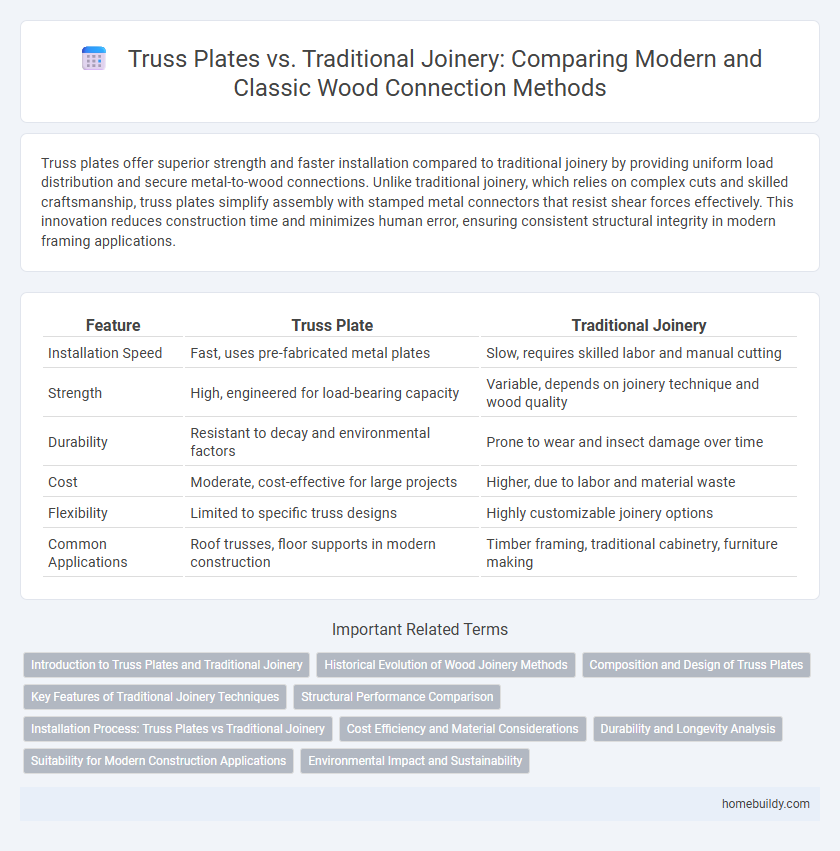Truss plates offer superior strength and faster installation compared to traditional joinery by providing uniform load distribution and secure metal-to-wood connections. Unlike traditional joinery, which relies on complex cuts and skilled craftsmanship, truss plates simplify assembly with stamped metal connectors that resist shear forces effectively. This innovation reduces construction time and minimizes human error, ensuring consistent structural integrity in modern framing applications.
Table of Comparison
| Feature | Truss Plate | Traditional Joinery |
|---|---|---|
| Installation Speed | Fast, uses pre-fabricated metal plates | Slow, requires skilled labor and manual cutting |
| Strength | High, engineered for load-bearing capacity | Variable, depends on joinery technique and wood quality |
| Durability | Resistant to decay and environmental factors | Prone to wear and insect damage over time |
| Cost | Moderate, cost-effective for large projects | Higher, due to labor and material waste |
| Flexibility | Limited to specific truss designs | Highly customizable joinery options |
| Common Applications | Roof trusses, floor supports in modern construction | Timber framing, traditional cabinetry, furniture making |
Introduction to Truss Plates and Traditional Joinery
Truss plates, made from galvanized steel and featuring punched teeth, provide strong, consistent connections in timber framing, enhancing structural integrity and easing installation compared to traditional joinery methods. Traditional joinery relies on handcrafted woodworking techniques such as mortise and tenon or dovetail joints, which require specialized skills and more time-consuming labor. The use of truss plates streamlines construction processes and improves load distribution, making them a preferred choice in modern timber construction.
Historical Evolution of Wood Joinery Methods
Truss plates revolutionized wood joinery by enabling faster and more consistent assembly compared to traditional joinery methods like mortise and tenon or dovetail joints, which evolved over centuries to prioritize craftsmanship and structural integrity. Traditional joinery required skilled labor and precision hand tools, reflecting historical wood construction techniques dating back to ancient civilizations, while truss plates emerged in the 20th century with the rise of industrialized building practices. The shift from artisanal joinery to metal connector plates marked a pivotal change in wood framing, optimizing load distribution and simplifying construction workflows in modern architecture.
Composition and Design of Truss Plates
Truss plates are typically composed of galvanized steel with multiple teeth designed for rapid and secure fastening, providing consistent strength and durability in wood framing. Traditional joinery relies on intricately cut wood joints, such as mortise and tenon, which require skilled craftsmanship and often result in variable structural integrity. The engineered design of truss plates enables efficient load distribution and quicker assembly compared to the labor-intensive process of traditional joinery methods.
Key Features of Traditional Joinery Techniques
Traditional joinery techniques emphasize precise woodworking methods such as mortise and tenon, dovetail, and tongue and groove joints, ensuring strong mechanical connections without metal fasteners. These methods rely on the natural strength of wood interlocking, promoting durability and aesthetic craftsmanship in timber framing. Unlike truss plates, traditional joinery allows for easier disassembly and repair, which benefits restoration and custom carpentry projects.
Structural Performance Comparison
Truss plates provide superior load distribution and increased shear strength compared to traditional joinery methods like mortise and tenon or dovetail joints, enhancing overall structural integrity. Engineered from galvanized steel with stamped teeth, truss plates offer consistent and reliable connections capable of withstanding higher stresses and reducing joint failures. Traditional joinery relies heavily on craftsmanship and wood-to-wood contact, which often results in weaker joints under dynamic loads and increased susceptibility to environmental factors.
Installation Process: Truss Plates vs Traditional Joinery
Truss plates offer a significantly faster installation process compared to traditional joinery methods, as they require less skilled labor and can be quickly pressed or nailed onto wood components. Traditional joinery often involves time-consuming cutting, fitting, and securing of joints, demanding higher craftsmanship and tools. This efficiency in truss plate installation reduces project timelines and labor costs, making it a preferred choice in modern construction.
Cost Efficiency and Material Considerations
Truss plates offer significant cost efficiency compared to traditional joinery by reducing labor time and minimizing skilled craftsmanship requirements, leading to lower overall project expenses. Materials used in truss plates, typically galvanized steel, provide enhanced durability and corrosion resistance, which extends the lifespan of structural connections without the need for expensive maintenance. Traditional joinery often demands higher material costs due to intricate wood cutting and additional fasteners, whereas truss plates streamline the assembly process with standardized, prefabricated components.
Durability and Longevity Analysis
Truss plates offer superior durability compared to traditional joinery due to their galvanized steel construction that resists corrosion and maintains structural integrity under heavy loads. Unlike conventional wood joints that can weaken over time from moisture and temperature changes, truss plates provide consistent longevity by distributing stress evenly across the connection. This engineered approach results in longer-lasting frameworks, especially in environments demanding high structural performance and minimal maintenance.
Suitability for Modern Construction Applications
Truss plates offer superior suitability for modern construction applications due to their high strength-to-weight ratio and ease of installation compared to traditional joinery. These metal connectors enable faster assembly and ensure consistent structural integrity in engineered timber frameworks. Modern building codes increasingly favor truss plates for their efficiency and reliability in large-scale, prefabricated construction projects.
Environmental Impact and Sustainability
Truss plates reduce the need for excessive wood by enabling smaller timber sections to achieve strong connections, minimizing deforestation compared to traditional joinery that often requires larger or more complex cuts. Manufactured from recyclable galvanized steel, truss plates support sustainable construction practices by promoting material reuse and reducing waste. In contrast, traditional joinery often demands labor-intensive processes with higher energy consumption and potentially greater environmental footprint due to the use of adhesives or metal fasteners with limited recyclability.
Truss plate vs Traditional joinery Infographic

 homebuildy.com
homebuildy.com